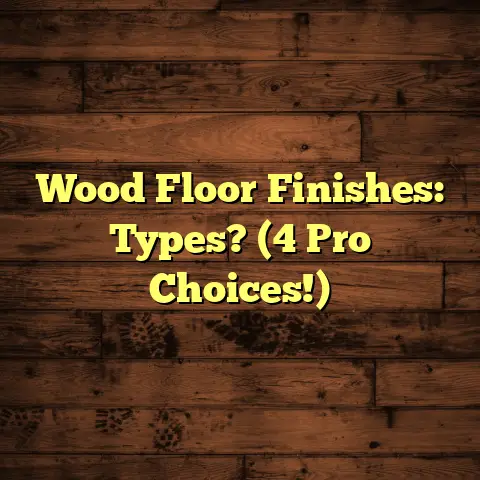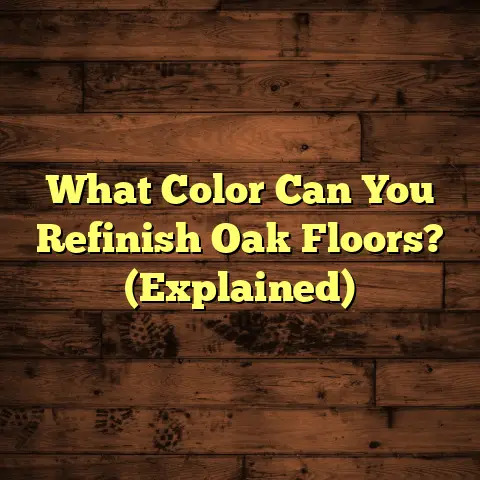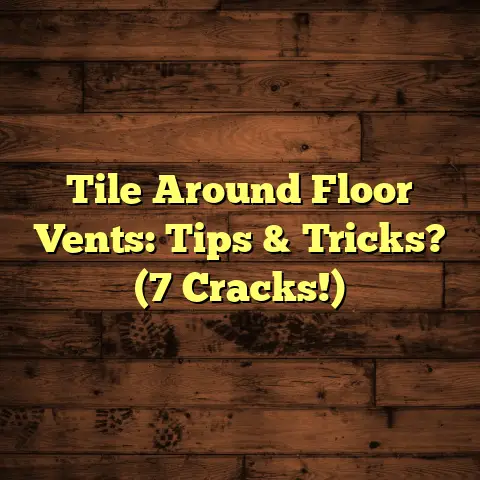How To Fix A Creaky Second Floor? (10 Noise Sources!)
Creaky floors. Ugh, right?
I’ve been a flooring contractor for over 20 years, and I can tell you, it’s one of the most common complaints I hear.
And it’s not just annoying; it can actually point to underlying issues that could affect your home’s value and livability.
Let’s dive in and figure out how to quiet those noisy ghosts in your house!
Regional Needs: Why Your Location Matters
Okay, before we get into the nitty-gritty, let’s talk about location.
Why?
Because what causes a floor to creak in, say, sunny Arizona, is going to be different than what causes it in humid Florida, or freezing Minnesota.
Think about it:
In Arizona, the dry air can cause wood to shrink, creating gaps.
In Florida, moisture can lead to expansion and warping.
Here’s a quick breakdown:
Humid Climates (Florida, Gulf Coast): Expect moisture-related issues.
Wood expands, potentially causing boards to rub against each other.-
Dry Climates (Arizona, Nevada): Wood shrinks, leading to gaps and loose boards.
-
Cold Climates (Minnesota, Maine): Temperature fluctuations cause expansion and contraction, leading to nail pops and shifting.
-
Coastal Areas: Salt air can accelerate corrosion of fasteners, leading to looseness.
Older homes, especially in historic districts, often have original flooring.
These floors are beautiful, but they’re also more prone to creaks because of their age and the materials used.
Modern constructions, on the other hand, might suffer from issues related to improper installation or the use of cheaper materials.
The bottom line?
Understanding your regional climate and your home’s construction style is the first step in diagnosing and fixing those annoying creaks.
Section 1: Understanding the Anatomy of a Floor
So, what’s actually under your feet?
Let’s break down the anatomy of a second floor.
Imagine your floor as a layered cake.
Each layer plays a crucial role:
-
Joists: These are the horizontal beams that support the entire floor. They’re the foundation.
Subflooring: This is the layer directly on top of the joists.
It’s usually made of plywood or OSB (oriented strand board).-
Finish Flooring: This is the pretty stuff you see and walk on – hardwood, laminate, carpet, tile, etc.
Think of the joists as the bones of your floor.
They carry the weight and provide the structure.
If they’re not strong enough, spaced properly,
or damaged, you’re going to have problems.
The subfloor is like the skin.
It provides a
smooth, stable surface for the finish flooring.
If it’s loose, warped, or improperly installed,
it’s a major creak culprit.
And the finish flooring?
Well, that’s the
icing on the cake.
It can contribute to creaks
if it’s not properly installed or if it’s
affected by moisture.
Wood expands when it’s warm and contracts when
it’s cold.
This constant movement can loosen
fasteners and create friction, leading to
creaks.
Section 2: Common Noise Sources (10 Culprits!)
Alright, let’s get down to the real detective work.
Here are the ten most common noise sources that lead to a creaky second floor.
1. Loose Floorboards
Ah, the classic!
Loose floorboards are often the easiest to spot.
What it is: When the nails or screws holding down your hardwood planks lose their grip, the boards start to shift.
What it sounds like: A distinct creak or squeak when you step on a particular spot.
What to look for: Visible gaps between boards, or boards that move slightly when you step on them.
Initial Inspection: Walk around your second
floor and pay attention to where the creaks
are loudest.
Press down on individual boards.
Do they move independently?
Why it happens: Over time, foot traffic and changes in humidity can cause the fasteners to loosen.
2. Improperly Installed Subfloor
This one’s a bit trickier to diagnose.
What it is: If the subfloor wasn’t properly secured to the joists during installation, it can move and rub against the joists, causing a symphony of squeaks.
What it sounds like: A more widespread creaking sound, often covering a larger area of the floor.
What to look for: This one’s harder to see, but if you have access to the basement or crawl space below, look for gaps between the subfloor and the joists.
How to check subfloor integrity: Try
pushing up on the subfloor from below (if you
have access).
Does it move easily?
That’s a
bad sign.
Why it happens: Rushing the installation process, using the wrong fasteners, or failing to properly glue the subfloor to the joists can all lead to this problem.
3. Inadequate Joist Spacing
What it is: Joists that are spaced too far apart can cause the subfloor to sag, leading to movement and noise.
What it sounds like: A deep, resonant creak, often accompanied by a feeling of “give” when you walk on the floor.
What to look for: Again, this one requires
access to the space below.
Check the distance
between the joists.
Industry standard joist spacing: 16 inches
on center for most residential applications.
If they’re further apart, you might have a
problem.
Why it happens: Cost-cutting measures during construction or a miscalculation of the load-bearing requirements can lead to inadequate joist spacing.
4. Moisture Damage
Water is the enemy of wood!
What it is: Water damage can cause wood flooring and subflooring to warp, swell, and rot, leading to all sorts of noises.
What it sounds like: A variety of sounds, from creaks to groans, depending on the extent of the damage.
What to look for: Water stains, discoloration,
or a musty smell are all red flags.
Check
around plumbing fixtures, windows, and exterior
walls.
Tips on identifying moisture issues: Use a
moisture meter to check the moisture content of
the wood.
Anything above 12% is cause for
concern.
Why it happens: Leaky pipes, roof leaks, poor ventilation, and even high humidity can all contribute to moisture damage.
5. Wear and Tear
Time takes its toll on everything, including floors.
What it is: Over time, the constant use and stress on your flooring can simply wear down the materials, leading to creaks and groans.
What it sounds like: A general creakiness throughout the floor, rather than in specific spots.
What to look for: Visible signs of wear, such as scratches, dents, and worn-out finish.
Why older floors are more susceptible: Older floors often have weaker fasteners and materials that have simply lost their elasticity over time.
6. Fastener Issues
Nails and screws aren’t forever.
What it is: Over time, nails and screws can loosen, corrode, or even break, leading to movement and noise.
What it sounds like: A sharp squeak or creak when you step near a fastener.
How to inspect and replace fasteners: Look
for nail heads that are popping up or screws
that are stripped.
You can try hammering the
nails back in or replacing the screws with
longer, stronger ones.
Why it happens: Changes in humidity, foot traffic, and the natural settling of the house can all contribute to fastener issues.
7. Expansion Gaps
What it is: Wood flooring needs room to
expand and contract with changes in humidity.
If there isn’t enough space around the edges
of the room, the flooring can buckle and creak.
What it sounds like: A loud creak or pop, especially during seasonal changes.
Why neglecting these leads to noise: When the flooring expands and has nowhere to go, it puts pressure on the subfloor and walls, leading to noise.
What to look for: Check the perimeter of the
room.
There should be a small gap (usually
about ¼ inch) between the flooring and the wall.
8. Flooring Material
Not all flooring is created equal.
What it is: Different types of flooring materials have different properties and are prone to different types of noises.
Hardwood: Can creak due to loose boards, moisture damage, or fastener issues.
Laminate: Can creak if the subfloor is uneven or if the planks are not properly locked together.
Carpet: Less prone to creaking, but can sometimes squeak if the padding underneath is worn out or improperly installed.
Why some materials creak more: Hardwood is
a natural material that expands and contracts,
making it more susceptible to creaking.
Laminate
is more rigid, but can creak if it’s not
installed properly.
9. Environmental Factors
Mother Nature plays a role.
What it is: Environmental elements like humidity and temperature can exacerbate floor noise.
How humidity and temperature affect noise:
High humidity causes wood to expand, while low
humidity causes it to contract.
These changes
can loosen fasteners and create friction, leading
to creaks.
What to do: Maintain a consistent indoor climate with a humidifier or dehumidifier to minimize the effects of environmental factors.
10. Improper Underlayment
The unsung hero of quiet floors.
What it is: Underlayment is a layer of
material installed between the subfloor and the
finish flooring.
It provides cushioning, sound
insulation, and moisture protection.
The role of underlayment in sound insulation: A good underlayment can absorb impact noise and prevent it from traveling through the floor structure.
Why skipping this step increases noise: Without underlayment, the finish flooring is more likely to rub against the subfloor, creating creaks and squeaks.
Section 3: Diagnosing the Problem
Okay, you’ve got the list of suspects.
Now,
how do you figure out which one is the culprit
in your house?
Here’s my step-by-step guide:
-
Listen Carefully: Walk slowly across your second floor, paying close attention to where the noises are coming from.
-
Mark the Spots: Use painter’s tape to mark the exact location of each creak.
Press and Prod: Press down on the floor around the marked spots.
Does the floor feel loose or springy?-
Check for Gaps: Look for gaps between the floorboards, the subfloor, and the walls.
-
Go Below (If Possible): If you have access to the basement or crawl space, inspect the joists and subfloor for signs of damage or looseness.
Creating a Checklist:
Here’s a simple checklist you can use to narrow down the possibilities:
- [ ] Loose Floorboards: Visible gaps or movement.
- [ ] Improperly Installed Subfloor: Widespread creaking, movement from below.
- [ ] Inadequate Joist Spacing: Deep creaks, sagging floor.
- [ ] Moisture Damage: Water stains, musty smell, high moisture readings.
- [ ] Wear and Tear: General creakiness, worn finish.
- [ ] Fastener Issues: Sharp squeaks near fasteners.
- [ ] Expansion Gaps: Loud creaks near walls.
- [ ] Flooring Material: Consider the type of flooring you have.
- [ ] Environmental Factors: Seasonal changes affect the noise.
- [ ] Improper Underlayment: Increased noise, especially impact noise.
Section 4: Temporary Fixes vs. Permanent Solutions
Alright, you’ve identified the problem. Now, what do you do about it?
There are two main approaches: temporary fixes and permanent solutions.
Temporary Fixes: These are quick, easy, and often inexpensive solutions that can help reduce the noise in the short term.
-
Talcum Powder: Sprinkle talcum powder into the gaps between floorboards to reduce friction.
-
WD-40: Spray WD-40 on squeaky hinges or fasteners.
-
Shims: Insert shims between the subfloor and the joists to stabilize the floor.
Pros: Quick, easy, inexpensive.
Cons: Only a temporary solution, doesn’t address the underlying problem.
Permanent Solutions: These are more involved and often more expensive, but they address the root cause of the creaking and provide a long-lasting solution.
-
Reinforcing Joists: Add additional joists or sister joists to strengthen the floor structure.
-
Replacing Subflooring: Remove and replace damaged or improperly installed subflooring.
-
Re-nailing or Screwing: Secure loose floorboards with new nails or screws.
-
Adding Underlayment: Install underlayment beneath the finish flooring to improve sound insulation.
Pros: Addresses the underlying problem, provides a long-lasting solution.
Cons: More involved, more expensive, may require professional help.
When to Choose Which:
-
Temporary Fixes: Use these for minor creaks or as a stopgap measure until you can implement a permanent solution.
-
Permanent Solutions: Use these for more serious creaks or when you want to address the underlying structural issues.
Conclusion
Creaky floors are a common problem, but they
don’t have to be a permanent one.
By understanding
the anatomy of your floor, identifying the
noise sources, and choosing the right solution,
you can quiet those noisy ghosts and enjoy a
peaceful second floor.
Remember:
- Location Matters: Climate and construction style play a big role.
- Diagnose Carefully: Use the checklist to pinpoint the problem.
- Choose Wisely: Decide between temporary fixes and permanent solutions.
Don’t let those creaks drive you crazy!
Take
action, address the problem methodically, and
enjoy the peace and quiet of a well-maintained home.
And if you’re not comfortable tackling the problem yourself, don’t hesitate to call in a professional.





